The Averoff Museum: Metsovo’s Cultural Legacy
At 1,160m, Metsovo blends preserved mountain...
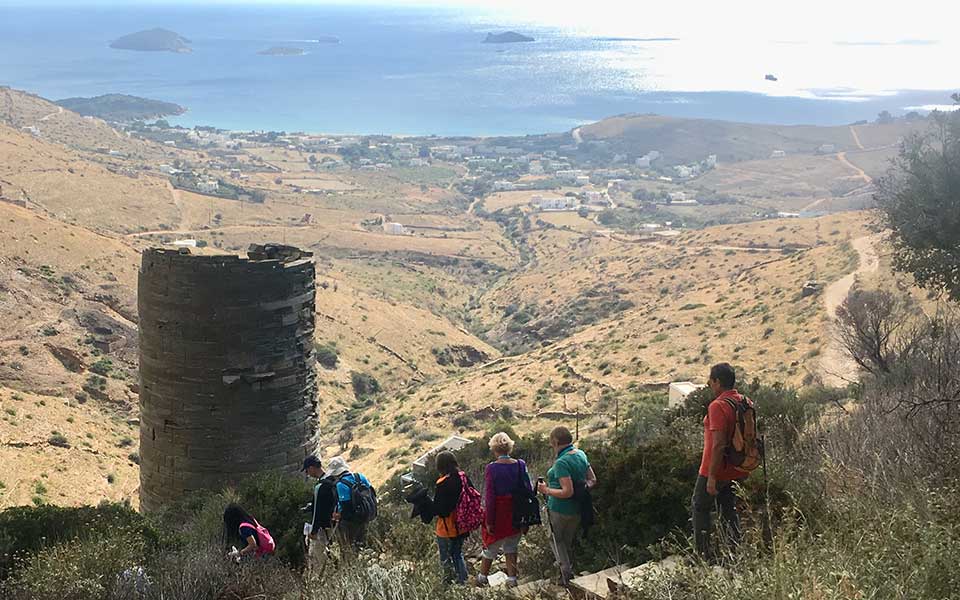
Walking on route 15, north-west Andros, during the 2nd Andros on Foot Festival (2019) at Agios Petros ancient tower (c. 4th-5th century BC).
© Andros Routes
It was like standing on the edge of the world. Water cascaded from the falls behind me, wild flowers wound around my feet, and beyond there was nothing but pure blue: the endless Aegean mingling hazily with the sky.
I hadn’t seen another person for hours as I traversed the hills and, as a white butterfly flittered past, I thought: How does this island, so accepting and so beautifully designed for exploration, still feel raw and untouched?
I was in Andros and I was about to find out the answer.
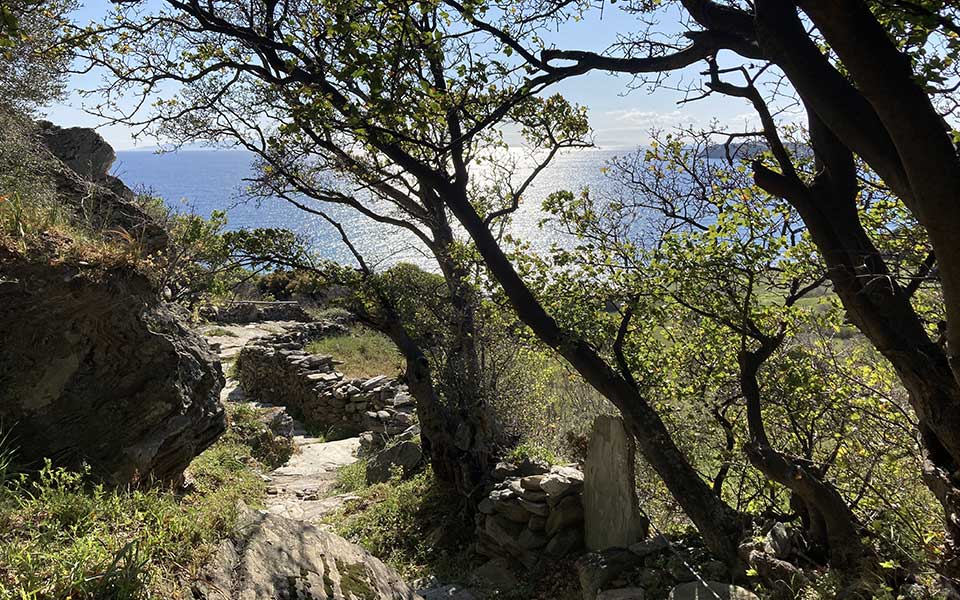
The paths offer sweeping views over the Aegean.
© Andros Routes
Andros is the second biggest island in the Cycladic archipelago, two-hours by boat from Athens and close by Mykonos and Naxos. Yet it’s like another world. It’s sparsely populated and boasts magnificent nature: four impressive mountain ranges (the highest rising 100 m), interrupted by rolling hills of diverse flora and fauna, rare wildlife and tranquil beaches.
There are four main towns: Gavrio, Batsi, Chora and Ormos Kothiou. Each has tavernas, cafes and shops; Chora has a renowned archeological museum and a modern art museum.
What makes this island different is something you can’t list; that you won’t find on any tourism board website. It’s the feel of it. The blissful awe of being on the landscape, walking the paths through the mountains, forests and rural villages, and the infectious joy of others doing the same.
Like long-time visitor Anna Kalatzi told us: “The paths have a magical power. I can’t describe how you feel when you walk through them. It’s like discovering another Andros.” And that, partly, is down to volunteer-led project Andros Routes.
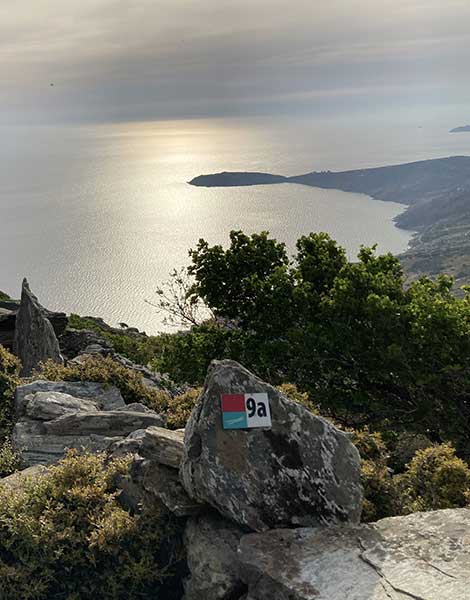
View from route 9a, from the central mountain range of Andros to the west coast, at Ano Paleopolis - the island's ancient capital for a thousand years (700 BC-700 AD).
© Andros Routes
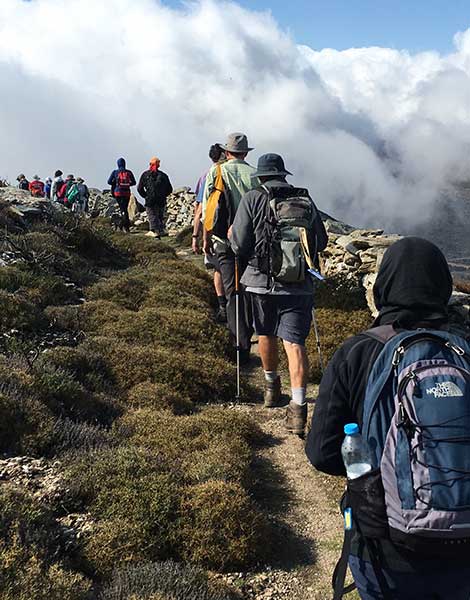
Walking on route 2 on the central mountain range of Andros rising to 1000 m altitude - the photo shows the part from Katakalei towards Vourkoti, the highest village on the island at 620 m altitude.
© Andros Routes
Since 2010, the team at Andros Routes have cleared and signposted the ancient shepherd’s routes that wind through the hills, recording and maintaining all 180 km, with an aim of attracting hikers as a more sustainable form of tourism.
Olga Karayiannis, Manager of non-profit Andros Research Center and Coordinator of Andros Routes, told us how it began: “At first, we were three people involved in researching the island. We wanted to transform our research into positive actions of sustainability for Andros. I could see the reality of the island: a beautiful place with amazing nature and culture. I thought it would be interesting to do something practical – to make a reality of theories about sustainability. I wanted to get deeper into the nature of the island; deeper into the society too. This turned into the Andros Routes project.”
The “continuous living project” has grown over the years thanks to the now 45-strong team of volunteers. One, Jola Gillespie, explained: “Each route has an ‘owner’ to look after it and clean it up… When a route belongs to you, you can walk it, take friends, meet other volunteers. People like the sense of accountability.”
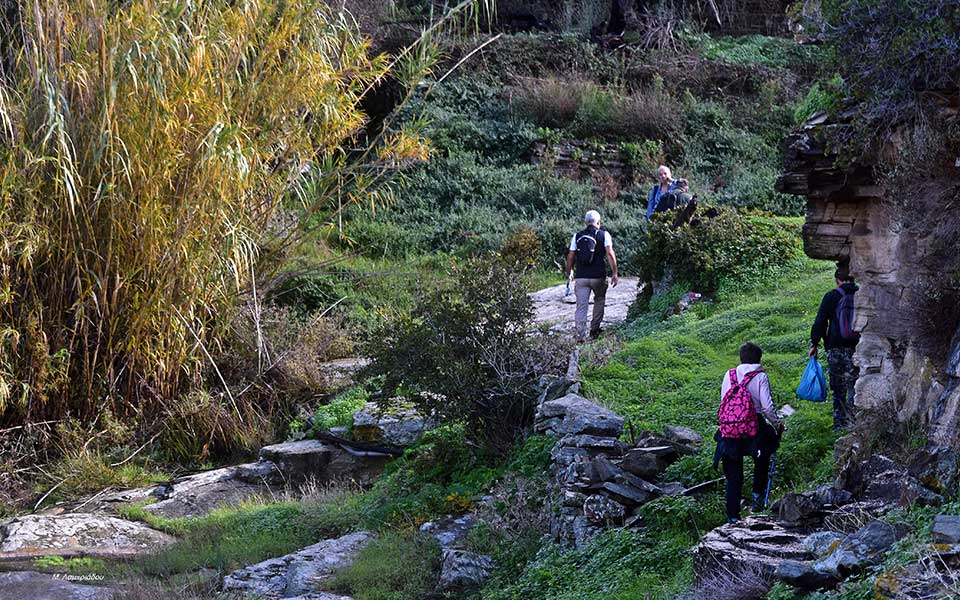
During a regular maintenance hike in southern Andros. On route 4 crossing one of the hundreds of streams on the island, after Nionas village towards Korthi.
© Andros Routes
Project-workers also help to market Andros’ routes and organize island events so visitors engage with local communities. Jola co-ordinated Andros Routes’ biggest festival. It’s clear the volunteers are proud – and rightly so. The success of Andros Routes speaks for itself. The footpaths have become “part of the image of the island,” as Olga says, “an important resource for tourists.” They help to boost the local economy and bring in visitors from across the world, all the year round.
In 2015, the 100 km continuous path across the length of the island – called the Andros Route – was certified as a Leading Quality Trail. Thus, Andros became the first island in Europe to be recognized by the European Ramblers Association.
The quality is tangible as you hike the hills, following unobtrusive signposts across paths that are clear and walkable whilst somehow still seeming wild. They’re organized but retain that magnificent ancient character that celebrates the natural island and Andros’ important agricultural history.
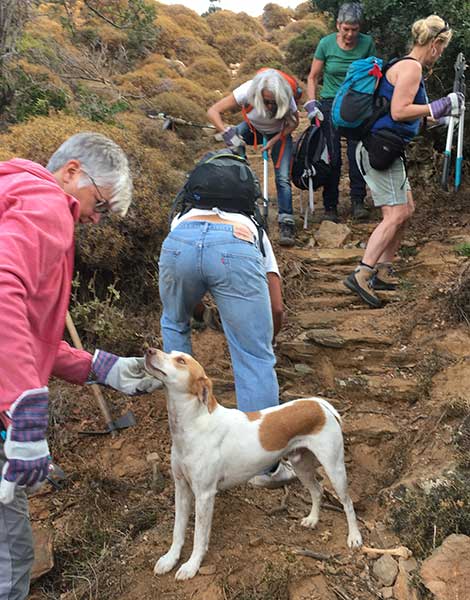
Andros Routes volunteers working together with Dutch volunteers from SNP travel organization in 2017.
© Andros Routes
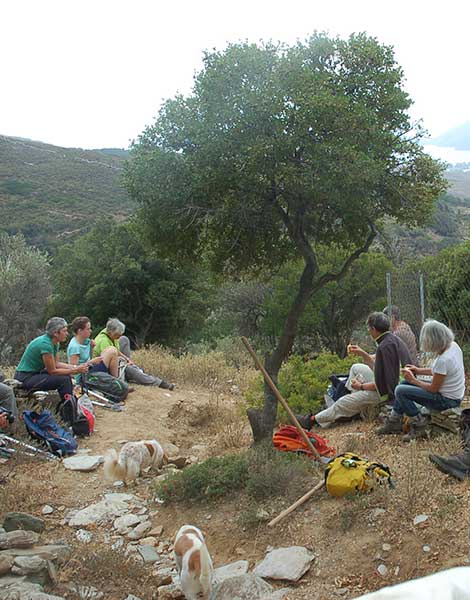
Taking a break during a trip organized to support the paths clearing.
© Andros Routes
As I walked, I crossed mountains, forests and rivers. Spectacular views met me at every turn; lizards, goats and butterflies joined the expedition. I found remote villages and secluded churches, all with a sense of history. There has been a human presence on Andros since the 4th millennia BC and you can feel it. “A lot of landscape you see may be ancient, untouched for thousands of years,” says Olga.
The atmosphere in the towns is special too as Andros Routes’ model of sustainable tourism seems to have attracted the right kind of tourist. Refreshing post-hike in one of Batsi’s tavernas, I found myself in the company of other walkers, all tired but happy from a day of appreciating the beauty of the island. Nearly everyone was in hiking boots and shorts – ruddy-faced and smiling – tucking into souvlaki or moussaka with a side of well-earned wine. I felt part of a community built on positivity.
Olga says: “I think [Andros tourism] is as sustainable as it can be. The people coming are sensitive. They care about the environment. They are interested in the local traditions, the local food. People understand there is a natural, cultural value all over Andros so they care to preserve it.”

View of Ormos Korthiou (Korthi bay) from route 3, south east Andros.
© Andros Routes
While tourism models in other areas may have resulted in identity loss, Andros Routes wants to celebrate theirs by promoting the ancient pathways that “express the relationship between humans and nature for centuries, revealing the special culture of the place” [www.androsroutes.gr]. Volunteer Ulli Stahlmann says: “I think some local people asked themselves, Why are people coming from all over the world, like Australia, to hike on Andros? There must be something interesting and special here.”
“It’s very touching – all the people who have seen young people leaving the smaller villages and suddenly, there are people hiking in them. Once, we were hiking in a group of 30 when two older ladies in one of the villages came out and offered us grapes, oranges, cookies. They were telling us how wonderful it was that there’s some life in the village.”
Olga adds: “The people still living in remote villages here produce many things themselves – the last ones to hold this long heritage. After the Second World War, rural areas of Greece were depopulated. Agriculture declined severely. Now, they see all these people visiting their villages. It’s like you’re helping them become proud again of what they have and who they are. That’s not a number, it’s not a tourism earning or something for visitors. It’s an intangible value that you can only feel when you are part of this.”
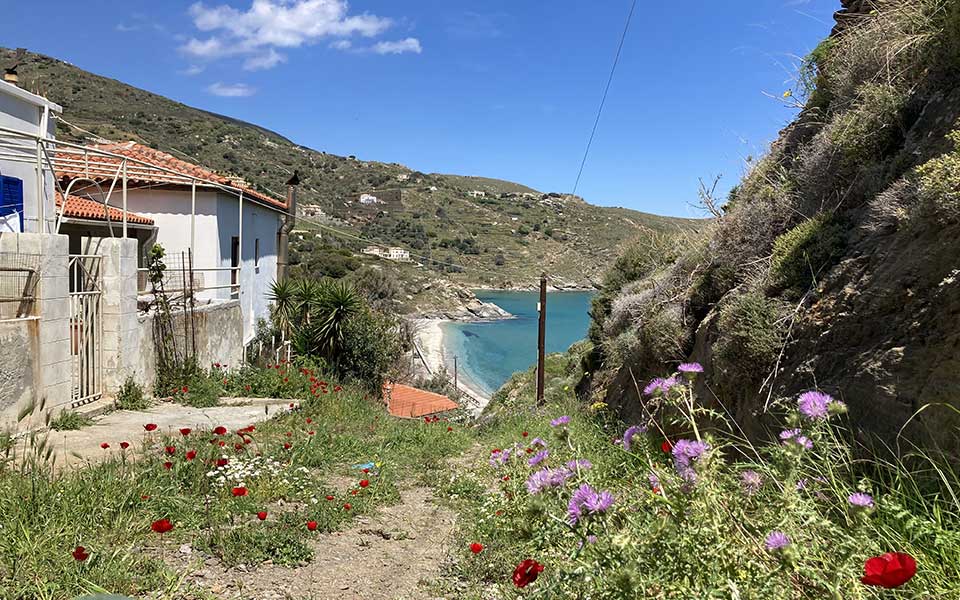
View from route 8a from Nimborio (Chora port) to Gialia beach - central Andros - east coast.
© Andros Routes
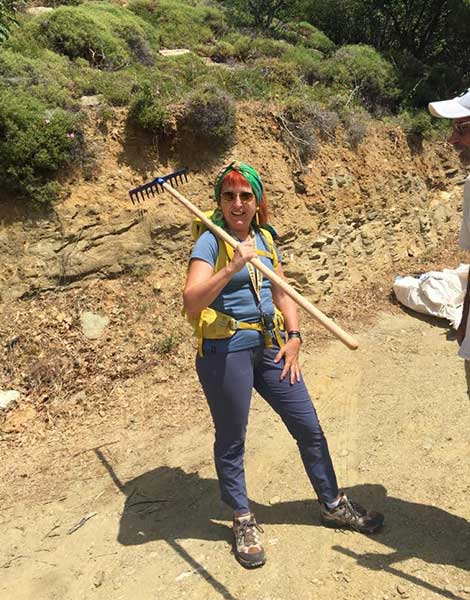
Anna Kalatzi, Andros Routes Angels (volunteers) coordinator in action in 2021.
© Andros Routes
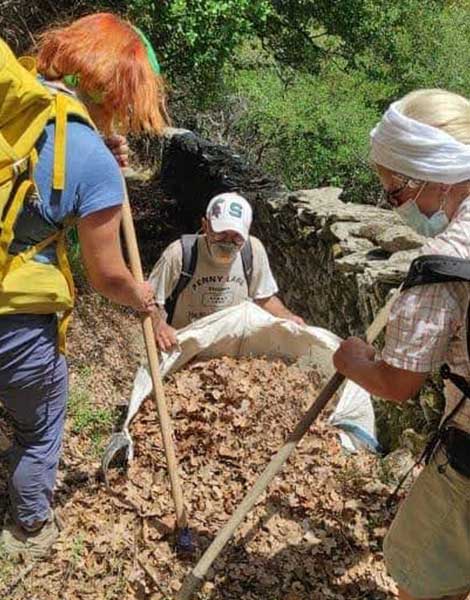
Andros Routes Angels (Anna Kalatzi, Yiannis Tridimas, Klio Mentiz) - local volunteers in action clearing leaves along route 10a at Ano Evrousses - central Andros.
© Andros Routes
Since lockdown, locals have been walking the paths and rediscovering their island. One told Olga she’d taken her 10-year-old son for the first time: “He said it was the best day of his life. If you ask me, this is more important than all the visitors.”
As part of the project, the team records oral history to ensure the island’s heritage is preserved, sharing stories of local people and collecting old photographs.
Each year, at the Andros On Foot festival, they invite visitors to take part in group hikes, meet locals, discover villages and learn about the island through talks and landmark visits. At the end of each day, the local cultural associations cook traditional meals for all to enjoy using reduced-waste programs. The atmosphere lights up the island.
Andros Research Center’s newest initiative Clean Green Andros, supported by the Cyclades Preservation Fund, aims for Andros to become a greener island. They hope to encourage recycling and composting, and reduce single-use plastic and landfill waste. This should further set Andros apart as an area of unspoiled natural beauty.
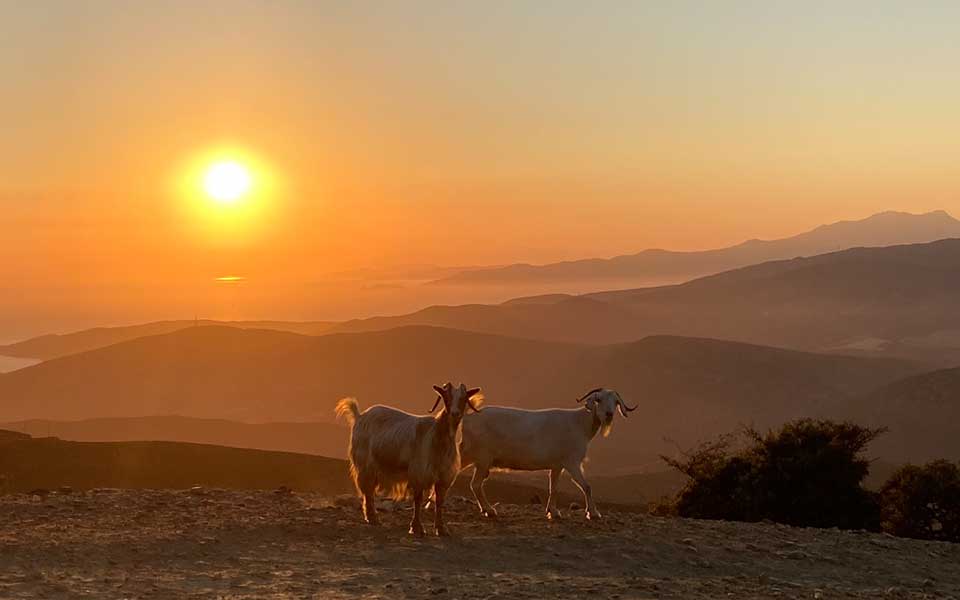
© Andros Routes
Being on Andros is a singular feeling. There’s a sense of joy amongst visitors and locals alike. There’s a happiness born from the idea that people are there to be part of the island: to respectfully enjoy it and to appreciate all of it.
The initiatives in Andros are a shining example of what sustainable tourism in Greece can achieve. It’s what makes Andros so special – the very reason this writer fell in love with the place and extended her stay again, and again.
Ulli says: “I arrived 30 years ago, and I’m still here. That’s what happens. We have a friend who calls it the ‘Andros feeling’: you get it and you never want to leave.”
At 1,160m, Metsovo blends preserved mountain...
Two years after the devastation caused...
Greece Is presents "Peloponnese Trails," a...
Shady hiking trails, a vibrant cultural...